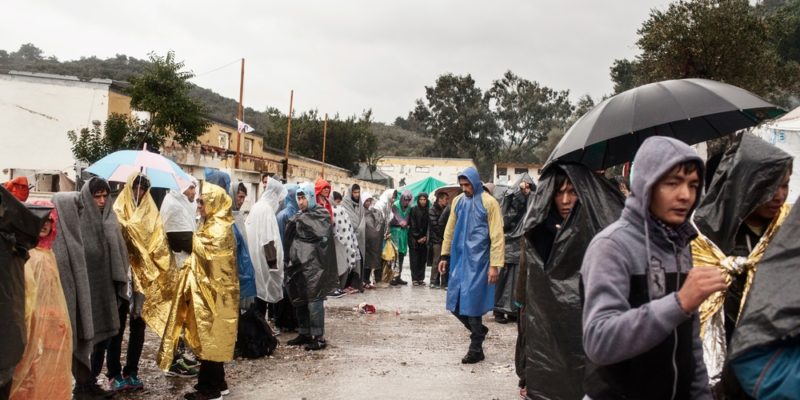1. Libya, Lesbos, Nauru: escape is the only solution
A Somali man in his late twenties reportedly set himself on fire in the Libyan detention centre of Triq al Sikka, the Irish Times reported.
Thousands of people are living in desperate conditions inside the Moria detention camp on Lesbos (while the special feature on the camp has yet to be broadcast on Italian national TV), the same conditions facing the migrants who tried to reach Australia only to end up stranded on Nauru Island.
According to Marco Bertotto, advocacy manager of Medici Senza Frontiere, the deterrence policies pursued by the EU and Australia against migrants, refugees and asylum seekers have led to tragic results. The only chance for continued protection for these people is to call for their immediate evacuation. You can now read his thoughts in Open Migration on the failed policies that are increasingly shown as a model to follow.
2. Caravan of hope – behind the exodus
Another week into their journey, the slow march of the Honduran migrants draws more and more people as it approaches the American border.
As the US response appears increasingly focused on the militarisation of borders, many are investigating the reasons behind this unprecedented exodus.
According to this article in Valigia Blu, travelling together allows migrants to avoid paying the high price demanded by people smugglers, and minimises the risk of falling prey to violence along the way.
3. Asylum and military aid: what happens to development funds
Asylum for refugees inside the EU, reduced debt for developing countries, as well as military training and externalisation, as Sara Prestianni explained in this article. This in-depth article in Openpolis guides us through the data on the funds allocated by the European Commission to development aid, which have dropped for the first time since 2012.
4. Libya not a safe country, Palermo court confirms
A court in Palermo that re-examined the case has ordered the release of the six Tunisian fishermen who assisted a boat in distress off the coasts of Lampedusa.
After being jailed under charges of abetting illegal immigration since August 30 – we told you their story in this article by Giulia Bertoluzzi and Valentina Zagaria– the Tunisian fishermen have been released since they could not have sent the migrants back to Libya “as it is not a safe haven”.
“There are no grounds to claim that they played a role in planning the journey – the ruling reads – and it is not very likely that they were fishing only to avoid drawing suspicions“.
Meanwhile, also due to a lack of search and rescue operations, deaths at sea between Libya and Italy are on the rise.
5. Idos immigration survey: numbrer of foreign residents in Italy stable since 2013
There are a little over 5 million foreign residents in Italy, making up 8,5% of the total population, a number which has remained more or less stable since 2013. Data from the Idos Statistical Dossier on Immigration shows a drop in the number of sea arrivals: 119.000 (-62,000 from 2016). The drop in arrivals comes with at a steep human cost: according to the IOM, there were 1,728 in the Mediterranean between January and September 2018, with 1.260 along the Libya-Italy route alone.
6. The Spanish government plan for unaccompanied foreign minors
There are 12,000 unaccompanied foreign minors in Spain, mostly living in Andalusia. The Council of Ministers approved last week their redistribution across the various Spanish regions. The intent of the government is to ensure better conditions for hospitality, also thanks to specifically allocated funds – 40 million euros to be divided according to the number of minors taken in. According to the newspaper El Publico, however, the plan has been met with opposition by the autonomous communities: reportedly, they have accepted to take in only 200 minors.
7. What are migrants running from?
33,770 men, women and minors from Africa, Asia and Europe sought international protection in Italy during the first six months of 2018. Their number is decreasing, but they keep drawing attention from politicians and the media, often with an oversimplifying approach.
Read the article in Carta di Roma on the reasons that have driven hundreds of thousands of people to attempt long, dangerous journeys, not all of them fleeing wars.
8. Uganda welcomes refugees other rich nations reject
Military forces dispatched to patrol borders, externailisation and offshore detention: whether it’s the EU, Australia or the USA, leaders are doing everything in their power to block migrants instead of taking them in. Surprisingly, an emerging African country has provided a lesson in hospitality. The New York Times takes us to Uganda, where more than a million refugees are estimated to live and where the foreign aid destined for refugees are benefiting the whole society.
9. Rome’s Baobab center struggling against barriers and fences
Concrete barriers and a 3-meter fence have met the volunteers from the Baobab centre in Rome, where about 200 migrants and refugees are hosted informally. The activists are fearing another evacuation and are finding it increasingly harder to provide assistance or even deliver water and hot meals.
10. The new Balkan route goes through Bosnia
Neither the wall built by Hungary, nor the tightening of patrols along the Serbian-Croatian border have been able to discourage thousands of people from travelling along the Balkan route. What they have managed to do is change the route, making Bosnia, so far untouched by the exodus, a central node in the journey.
As over 13,000 migrants have chosen Bosnia as a transit country on their way to Europe (data from IOM), the cities of Velika Kladusa and Bihac, along the Croatian Border, have gradually become a bottleneck. Recently, the two towns have seen protests from both migrants and residents, and the tensions continued throughout the week, as Melting Pot reported.
In copertina: centro di accoglienza di Moria a Lesbo. Foto di Alessandro Penso









